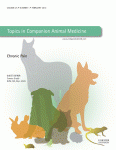
Cancer, cancer pain, and the undertreatment of cancer pain are epidemic in both the human and veterinary medical field. Concerns over recognition, assessment, and treatment of oncologic pain in our veterinary patients are multiplied when one realizes the interaction of the primary tumor, the pain itself, and even cancer treatments with fatigue, disability, dyspnea, weakness, impaired gastrointestinal motility, cognition, and urinary/defecation issues. The patient's overall health status, as well as owner psychological and spiritual distress, plays a large part in quality-of-life decisions. We will discuss classification and assessment of cancer pain, quality-of-life issues, and therapies for managing cancer pain, including pharmacologic, nonpharmacologic, and interventional techniques. The goal will be establishment of a new oncologic treatment pyramid or scale for veterinary patients, one that will guide clinicians mechanistically into thinking through the anamnesis, physical examination, and assessment of the whole patient, and on toward diagnostics and treatments available for companion animals with cancer.
Article Outline